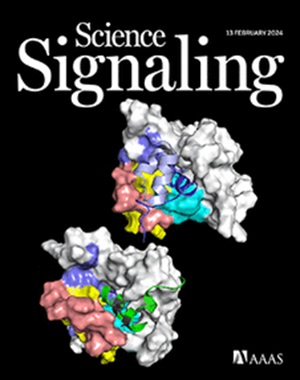Structural insights into the high basal activity and inverse agonism of the orphan receptor GPR6 implicated in Parkinson’s disease
IF 6.6
1区 生物学
Q1 BIOCHEMISTRY & MOLECULAR BIOLOGY
引用次数: 0
Abstract
GPR6 is an orphan G protein–coupled receptor with high constitutive activity found in D2-type dopamine receptor–expressing medium spiny neurons of the striatopallidal pathway, which is aberrantly hyperactivated in Parkinson’s disease. Here, we solved crystal structures of GPR6 without the addition of a ligand (a pseudo-apo state) and in complex with two inverse agonists, including CVN424, which improved motor symptoms in patients with Parkinson’s disease in clinical trials. In addition, we obtained a cryo–electron microscopy structure of the signaling complex between GPR6 and its cognate Gs heterotrimer. The pseudo-apo structure revealed a strong density in the orthosteric pocket of GPR6 corresponding to a lipid-like endogenous ligand. A combination of site-directed mutagenesis, native mass spectrometry, and computer modeling suggested potential mechanisms for high constitutive activity and inverse agonism in GPR6 and identified a series of lipids and ions bound to the receptor. The structures and results obtained in this study could guide the rational design of drugs that modulate GPR6 signaling.
孤儿受体GPR6与帕金森病相关的高基础活性和逆激动作用的结构见解。
GPR6是一种孤儿G蛋白偶联受体,具有高组成活性,存在于纹状体通路的d2型多巴胺受体表达的中棘神经元中,在帕金森病中异常亢进。在这里,我们在不添加配体(伪载脂蛋白状态)的情况下解决了GPR6的晶体结构,并与两种反向激动剂(包括CVN424)配合使用,在临床试验中改善了帕金森病患者的运动症状。此外,我们获得了GPR6与其同源的Gs异源三聚体之间的信号复合物的低温电镜结构。伪载脂蛋白结构在GPR6的正位口袋中显示出与脂质样内源性配体相对应的强密度。位点定向诱变、天然质谱和计算机建模的结合表明,GPR6具有高组成活性和反向激动作用的潜在机制,并确定了一系列与受体结合的脂质和离子。本研究获得的结构和结果可以指导GPR6信号调节药物的合理设计。
本文章由计算机程序翻译,如有差异,请以英文原文为准。
求助全文
约1分钟内获得全文
求助全文
来源期刊

Science Signaling
BIOCHEMISTRY & MOLECULAR BIOLOGY-CELL BIOLOGY
CiteScore
9.50
自引率
0.00%
发文量
148
审稿时长
3-8 weeks
期刊介绍:
"Science Signaling" is a reputable, peer-reviewed journal dedicated to the exploration of cell communication mechanisms, offering a comprehensive view of the intricate processes that govern cellular regulation. This journal, published weekly online by the American Association for the Advancement of Science (AAAS), is a go-to resource for the latest research in cell signaling and its various facets.
The journal's scope encompasses a broad range of topics, including the study of signaling networks, synthetic biology, systems biology, and the application of these findings in drug discovery. It also delves into the computational and modeling aspects of regulatory pathways, providing insights into how cells communicate and respond to their environment.
In addition to publishing full-length articles that report on groundbreaking research, "Science Signaling" also features reviews that synthesize current knowledge in the field, focus articles that highlight specific areas of interest, and editor-written highlights that draw attention to particularly significant studies. This mix of content ensures that the journal serves as a valuable resource for both researchers and professionals looking to stay abreast of the latest advancements in cell communication science.
 求助内容:
求助内容: 应助结果提醒方式:
应助结果提醒方式:


